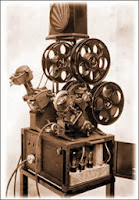From Analogue to Digital Editing
Analogue editing is the cutting together of pieces of celluloid film. Films are made up images printed on to acetate negatives. These are "spliced" together to form a reel of film. These are then fed through a projector at a constant speed of 24 frames which makes the pictures appear to be moving. This is known as analogue.


The first Moviola; before wide-spread use of non-linear editing systems, the initial editing of all film was done with a positive copy of the film negative called a film work print. (Cutting and copy in the UK) by physically cutting and pasting pieces of film, using a splicer and threading the film on a machine with a viewer such as a Moviola.


Before digital technologies became available, magnetic tapes were used to store information. These are known as video tapes. Most video editing has been superseded by digital
editing which is faster and cheaper.
editing which is faster and cheaper.
Digital media is a form of electronic media where data is stored in digital, as apposed to analogue, form. Digital editing is the use of computers to order and manipulate this digital data.
Digital cinema uses bits and bytes (strings of 1's and 0's) to record, transmit, and reply images, instead of chemicals on a film. The whole process is electronic so there is no printing or 'splicing' involved.
 Non-linear editing is a method that allows you to access any frame in a digital video clip regardless of the sequence in the clip. The freedom to access any frame and use a cut and paste method similar to the ease of cutting and pasting text in a word processor, and allows you to easily include fades, transitions, and other effects that cannot be achieved with linear editing.
Non-linear editing is a method that allows you to access any frame in a digital video clip regardless of the sequence in the clip. The freedom to access any frame and use a cut and paste method similar to the ease of cutting and pasting text in a word processor, and allows you to easily include fades, transitions, and other effects that cannot be achieved with linear editing.

